AT The Economic Times’s Global Business Summit in mid-January 2015, Prime Minister Narendra Modi clearly laid out his Transformation Agenda. After presenting a provocative poser—“India is a $2-trillion economy today. Can we not dream of an India with a $20-trillion economy?”—he unveiled his ‘doctrine of development’ in lucid terms: “The government must nurture an ecosystem where the economy is primed for growth; and growth promotes all-round development. Where development is employment-generating; and employment is enabled by skills. Where skills are synced with production; and production is benchmarked to quality. Where quality meets global standards; and meeting global standards drives prosperity. Most importantly, this prosperity is for the welfare of all.” With such seamless segueing, India will be transformed from a poor/low-income to a high-income/rich nation and poverty will stand eliminated.
There are two key words—‘growth’ and ‘development’. Growth refers to increased quantities of specific phenomena, such as jobs, population, and income. It also could be used to refer to changes in quality, such as better jobs or more secure sources of income. Lopsided growth could lead to poverty and inequality.
Development involves equitable change in the community, especially in how resources are used, the functioning of institutions, and the distribution of resources in the community. Balanced development could lead to prosperity and equity. The philosophy behind Modi’s Transformation Agenda is a judicious blend of ‘growth’ and ‘development’, which are often mixed-up with each other.
To facilitate such Transformation, just two weeks earlier, the Planning Commission (PC) was disbanded and reinvented as NITI (National Institution for Transforming India) Ayog with a multi-tiered structure, including a governing council that comprises the chief ministers of all States and lieutenant-governors of Union Territories. NITI Ayog will serve as a government think-tank with the mandate to provide strategic and technical advice on issues of national and international importance to the Centre and States.
 With the PM as Chairperson, this body has a Vice Chairperson and a Chief Executive Officer (CEO), some full-time members and two part-time members. Four Union ministers are ex-officio members. While the PC was primarily responsible for deciding on plan spending of the Centre and allocation to State governments, NITI Ayog will provide a national agenda framework for transformation for the Prime Minister and the chief ministers after evolving “a shared vision of national development priorities, sectors and strategies with the active involvement of states.” Columbia University Professor Arvind Panagariya is Ayog’s first Vice Chairperson and a flashy former IAS Officer Amitabh Kant, its CEO.
With the PM as Chairperson, this body has a Vice Chairperson and a Chief Executive Officer (CEO), some full-time members and two part-time members. Four Union ministers are ex-officio members. While the PC was primarily responsible for deciding on plan spending of the Centre and allocation to State governments, NITI Ayog will provide a national agenda framework for transformation for the Prime Minister and the chief ministers after evolving “a shared vision of national development priorities, sectors and strategies with the active involvement of states.” Columbia University Professor Arvind Panagariya is Ayog’s first Vice Chairperson and a flashy former IAS Officer Amitabh Kant, its CEO.
The resolution establishing NITI Ayog lays down 13 objectives. These range from fostering cooperative federalism to developing mechanisms for preparing credible plans at the village level; ensuring that national security concerns are taken on board in development policies; creating a knowledge, innovation and entrepreneurial support system; serving as a platform for coordinating inter-departmental issues; and, serving as a “repository of research on good governance and best practices in sustainable and equitable development”. NITI Ayog will evolve its own priorities from this long list, as per its rules of business.
Primarily the Ayog is meant to serve as a source of new ideas and achieve convergence between the Centre and States for evolving a long-term vision for India through coordination among the various departments of the Centre and governments in the States. The Ayog is expected ‘to pay special attention to the section of our society that may be at the risk of not benefiting adequately from economic progress’. This is to take care of the marginalised laggards. Another purpose was ‘providing advice and encouraging partnerships between key stakeholders and national and international like-minded think-tanks’.
NITI Ayog is Modi’s ‘Team India’ which he promised during his fiery electoral campaign. While the mandate eschews the word planning in its nomenclature, the objectives of the Ayog are unequivocal about ushering in village-level planning and aggregation of plans at progressively higher levels. This will involve the mammoth task of linking six lakh-plus villages with State governments and, in turn, the Central government, which would certainly throw up fresh and competing demands.
This brings us to the core of NITI Ayog’s mandate (as approved by the cabinet committee) and the caveat of evolving a ‘national vision based not on borrowed models but on India’s ground realities’. This is the original ‘idea of India’—a people-based governance with a bottom-up decision-making process that would give every citizen a ‘place in the sun’. Built on this premise was the ‘economic idea’ of equity envisaging independent India as sui generis, a society unlike any other, in a class of its own that would not follow the borrowed western pattern of mega industrialisation, urbanisation and individuation.
Under this scheme of things, India’s would be a people’s economy that would chart out a distinct course in economic growth, which would be need-based, human-scale, balanced development while conserving nature and livelihoods. In a self-respecting nation, every citizen should get the strength, resource, opportunity and level-playing-field to stand on his/her feet and earn livelihood with honour instead of eternally waiting for things to trickle down. Nature-given resources—land, water, forests and minerals—belong to the people and these must be managed as such. Only then there would be development with dignity.
IN any such development narrative, equitable growth leading to rapid job creation aiming at full-employment should be the fulcrum. This would call for decentralised and distributed labour-intensive development where entrepreneurship, value addition and job creation spreads out and reaches far and wide. But ever since the advent of the ‘Reform Era’ in early nineties, this narrative got completely skewed and growth has been capital-intensive, centralised and concentrated. This led to inequity—while GDP grew fast, jobs hardly grew. For instance, as per 2016-17 Labour Bureau data, GDP growth is 7 per cent plus, while job growth is just around 1 per cent. Under-employment is a staggering 35 per cent of the over-15 years labour force. The Organisation for Economic Co-operation and Development (OECD) report says that over 30 per cent Indian youth aged 15-29 are not in employment. This is more than double the OECD average of 14.6 per cent and three times that of China (11.2 per cent).This is a serious situation.
But NITI Ayog doesn’t seem to be concerned about this harsh ground reality. Instead, contrary to its mandate, the Ayog is harping on ‘borrowed models’ and is advocating super-duper technology driven jobless growth. This is evident from CEO Amitabh Kant’s repeated statements: “India is in the midst of huge disruption in the world of both financial technology and in terms of social innovation. In my view within the next two-and-half years India will make all its debit cards, credit cards, ATM machines and POS machines redundant as every Indian will do transaction just by using his thumb and mobile phones. The digital transaction would be done in just thirty seconds through Aadhar-enabled technology.”
What a profound statement in a country with these global rankings: Literacy rate-168; Human Development Index-131; Per capita GDP-122; Index of economic freedom-123; Global Hunger Index-97; Corruption Index-76; Ease of Doing Business Index-130; Press Freedom Index-133; Environment Performance Index-155; New Health Index-143 and Global Slavery Index-4. As for digital penetration, almost a billion Indians were offline even though India ranks among the top five nations in terms of internet users. Considering these realities, Kant’s contention must be the joke of the century!
As for advocating aggressive disinvestment and privatisation of public sector, NITI Ayog mandarins have out-run the market-maniac Montek Ahluwalia, Vice Chairman of the erstwhile Planning Commission. This has brought justifiable anger among the RSS-affiliate Bhartiya Mazdoor Sangh (BMS), which accuses the NITI Ayog of being instrumental in the misguided and direction-less reforms taking place in the country, lacking concerns of common man. It also alleges that the planning body has given an “anti-labour face” to the government, due to its proposals on labour law reforms. Charging the Ayog of furthering corporate lobby’s agenda in the country, BMS has demanded its reorganisation to make it “more broad-based with inclusion of farmer, labour and women representatives.”
There has not been any worthwhile development or job creation in recent years because the ‘transformation’ Modi sought while replacing the ‘static’ Planning Commission with the ‘dynamic’ NITI Ayog has not taken place. Naturally so, because the Ayog has lost track of its mandate and is wandering in the wilderness. Global Summits and taking agenda briefs from multinationals cannot deliver this transformation. Intense interaction in urban by-lanes and rural hinterland, where India’s laggards live, only can. And 2019 is not far off!
The writer is a former Army and IAS officer





























































